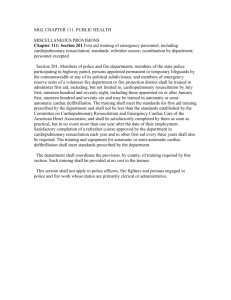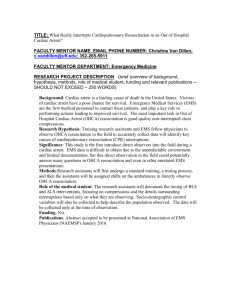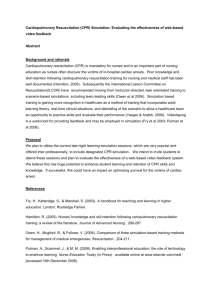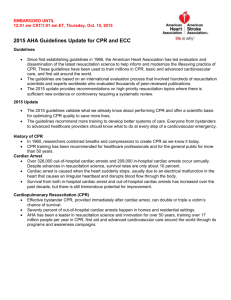UpToDate®: 'Controversies in cardiopulmonary resuscitation' http
advertisement
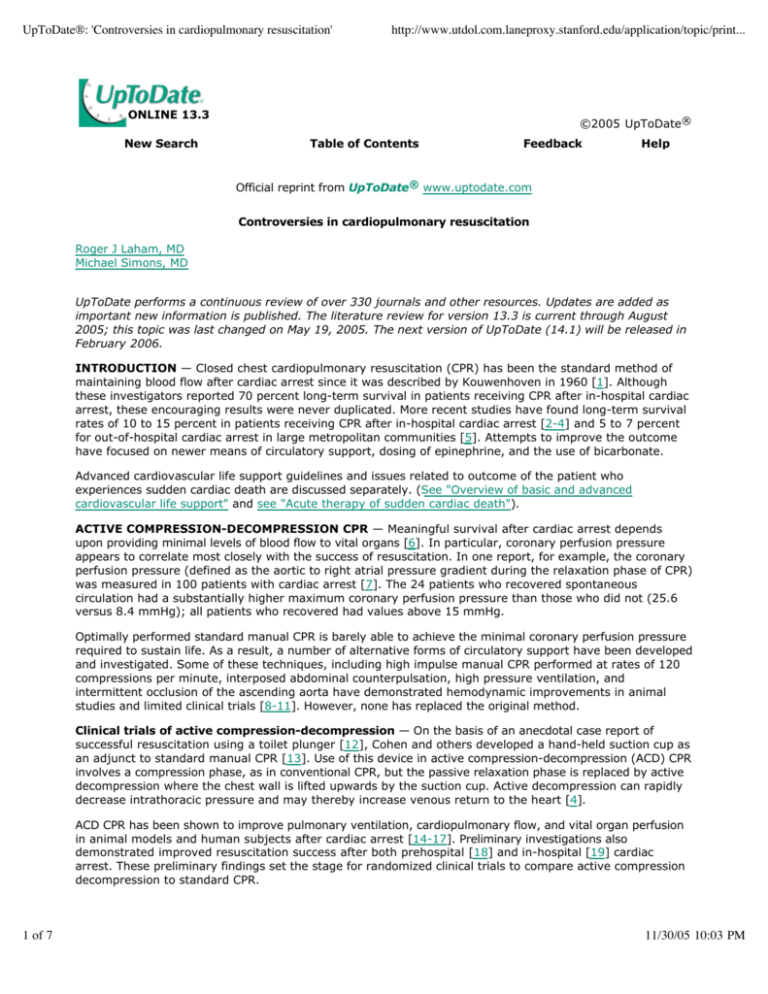
UpToDate®: 'Controversies in cardiopulmonary resuscitation' http://www.utdol.com.laneproxy.stanford.edu/application/topic/print... ONLINE 13.3 New Search ©2005 UpToDate® Table of Contents Feedback Help Official reprint from UpToDate® www.uptodate.com Controversies in cardiopulmonary resuscitation Roger J Laham, MD Michael Simons, MD UpToDate performs a continuous review of over 330 journals and other resources. Updates are added as important new information is published. The literature review for version 13.3 is current through August 2005; this topic was last changed on May 19, 2005. The next version of UpToDate (14.1) will be released in February 2006. INTRODUCTION — Closed chest cardiopulmonary resuscitation (CPR) has been the standard method of maintaining blood flow after cardiac arrest since it was described by Kouwenhoven in 1960 [1]. Although these investigators reported 70 percent long-term survival in patients receiving CPR after in-hospital cardiac arrest, these encouraging results were never duplicated. More recent studies have found long-term survival rates of 10 to 15 percent in patients receiving CPR after in-hospital cardiac arrest [2-4] and 5 to 7 percent for out-of-hospital cardiac arrest in large metropolitan communities [5]. Attempts to improve the outcome have focused on newer means of circulatory support, dosing of epinephrine, and the use of bicarbonate. Advanced cardiovascular life support guidelines and issues related to outcome of the patient who experiences sudden cardiac death are discussed separately. (See "Overview of basic and advanced cardiovascular life support" and see "Acute therapy of sudden cardiac death"). ACTIVE COMPRESSION-DECOMPRESSION CPR — Meaningful survival after cardiac arrest depends upon providing minimal levels of blood flow to vital organs [6]. In particular, coronary perfusion pressure appears to correlate most closely with the success of resuscitation. In one report, for example, the coronary perfusion pressure (defined as the aortic to right atrial pressure gradient during the relaxation phase of CPR) was measured in 100 patients with cardiac arrest [7]. The 24 patients who recovered spontaneous circulation had a substantially higher maximum coronary perfusion pressure than those who did not (25.6 versus 8.4 mmHg); all patients who recovered had values above 15 mmHg. Optimally performed standard manual CPR is barely able to achieve the minimal coronary perfusion pressure required to sustain life. As a result, a number of alternative forms of circulatory support have been developed and investigated. Some of these techniques, including high impulse manual CPR performed at rates of 120 compressions per minute, interposed abdominal counterpulsation, high pressure ventilation, and intermittent occlusion of the ascending aorta have demonstrated hemodynamic improvements in animal studies and limited clinical trials [8-11]. However, none has replaced the original method. Clinical trials of active compression-decompression — On the basis of an anecdotal case report of successful resuscitation using a toilet plunger [12], Cohen and others developed a hand-held suction cup as an adjunct to standard manual CPR [13]. Use of this device in active compression-decompression (ACD) CPR involves a compression phase, as in conventional CPR, but the passive relaxation phase is replaced by active decompression where the chest wall is lifted upwards by the suction cup. Active decompression can rapidly decrease intrathoracic pressure and may thereby increase venous return to the heart [4]. ACD CPR has been shown to improve pulmonary ventilation, cardiopulmonary flow, and vital organ perfusion in animal models and human subjects after cardiac arrest [14-17]. Preliminary investigations also demonstrated improved resuscitation success after both prehospital [18] and in-hospital [19] cardiac arrest. These preliminary findings set the stage for randomized clinical trials to compare active compression decompression to standard CPR. 1 of 7 11/30/05 10:03 PM UpToDate®: 'Controversies in cardiopulmonary resuscitation' http://www.utdol.com.laneproxy.stanford.edu/application/topic/print... Two such trials compared ACD CPR with standard CPR in a total of 1633 patients [20,21]. No significant differences in outcome were seen with either in-hospital or out-of-hospital cardiac arrest. Phased chest and abdominal compression-decompression — A new method for CPR, which combines ACD CPR and interposed abdominal compression techniques, has been associated with a significant increase in coronary perfusion pressure. A report of 50 patients found that this technique was more effective than conventional CPR for initial resuscitation of patients with asystole or pulseless electrical activity; however, none of the patients survived hospitalization [22]. Inspiratory impedance threshold device — The inspiratory impedance threshold device (IITD) is a small-volume valve that can be attached to either an endotracheal tube or a face mask during resuscitation. The IITD is designed to prevent air entry during chest decompression, thus prolonging the duration of the decompressive phase, increasing negative intrathoracic pressure, and improving venous return to the thorax. Animal models and small clinical trials of the IITD used alone or in combination with active compression-decompression devices have been promising [23-29]. As an example, one controlled trial randomly assigned 230 patients with out-of-hospital cardiac arrest to treatment with an IITD or a sham device in combination with standard CPR [28]. Patients treated with the device were significantly more likely than control patients to survive until ICU admission (25 versus 17 percent, respectively). Subgroup analysis suggested that patients with pulseless electrical activity (PEA) were more likely to benefit from IITD therapy than those with ventricular fibrillation or asystole. The IITD remains experimental, and the device is not available for clinical use at this time. Recommendation — In- and out-of-hospital cardiac arrest remains associated with a poor prognosis despite significant advances in intensive care management, advanced life support strategies, and accelerated response times. There is no clear evidence that ACD CPR is beneficial. Despite some improvements in hemodynamic indices and initial resuscitation rates, no statistically significant improvement in hospital discharge rate, the most important clinical outcome, has been demonstrated. We do not use ACD CPR or recommend its use at the present time. CPR BEFORE DEFIBRILLATION FOR VF — Most cases of cardiac arrest, including out-of-hospital cardiac arrest, are due to ventricular fibrillation (VF) (show figure 1). Survival for such patients depends upon prompt defibrillation. When VF has been present for seconds to a few minutes, the success rate of defibrillation is high. As VF continues for a longer period of time, the ability to terminate the arrhythmia is reduced. Furthermore, when VF continues for more than four minutes, there is irreversible damage to the central nervous system and other organs, which will reduce survival even if defibrillation is successful [30]. For these reasons, the standard of care for resuscitation from VF has been defibrillation as soon as possible. In a series of over 12,000 EMS-treated patients from Seattle, 4546 had witnessed VF. For these patients, the defibrillation response interval was significantly correlated with survival to hospital discharge (odds ratio 0.88 for every one-minute increase in response time) [31]. (See "Acute therapy of sudden cardiac death" and see "Overview of basic and advanced cardiovascular life support"). However, it has been suggested that outcomes may be improved by performing CPR before defibrillation, at least in patients in whom defibrillation is delayed for more than four to five minutes. In an initial report from Seattle describing such an approach, survival to hospital discharge was significantly increased with routine CPR before defibrillation, primarily in patients in whom the initial response interval was four minutes or longer (27 versus 17 percent without prior CPR) [32]. This benefit was confirmed in a subsequent controlled trial in which 200 patients presenting with out-of-hospital VF were randomly assigned to immediate defibrillation or CPR for three minutes prior to the first defibrillation attempt [33]. There were no differences in outcome between the two groups for patients with a response time 5 minutes. For those with response times >5 minutes, however, patients undergoing CPR first were significantly more likely to survive to hospital discharge (22 versus 4 percent). Recommendation — Despite the physiologic justification for performing CPR prior to defibrillation in patients with VF, the clinical trials data are not sufficient to recommend this practice. Furthermore, no protocol that would tend to result in delaying needed defibrillation for victims of cardiac arrest should be adopted without clear evidence of efficacy. Therefore, we do not recommend CPR prior to defibrillation for patients with cardiac arrest due to VF. HIGH-DOSE EPINEPHRINE — Epinephrine has been the standard vasopressor for cardiac arrest since the 2 of 7 11/30/05 10:03 PM UpToDate®: 'Controversies in cardiopulmonary resuscitation' http://www.utdol.com.laneproxy.stanford.edu/application/topic/print... 1960s [1,34,35]. As noted above, survival after cardiac arrest remains poor [2,3,5]. The outcome is particularly bad in patients whose cardiac rhythm is asystole, pulseless electrical activity (electromechanical dissociation), or refractory VF. Epinephrine remains the first-line adrenergic agent for such patients, but few studies in humans have assessed its efficacy or the correct dosage. Since its introduction, the recommended dose in adults has been 0.5 to 1 mg intravenously every five minutes. This dose was derived from studies in dogs, but does not allow for the large difference in weight between dogs and humans [36]. Clinical trials of high-dose epinephrine — Some animal studies have suggested that the use of much higher doses of epinephrine (0.07 to 0.20 mg/kg of body weight) results in increased coronary and cerebral blood flow and improved rates of survival [37,38]. In small human studies, investigators have demonstrated substantially better hemodynamic responses to 5 to 14 mg of epinephrine than 1 mg [39,40]. This led clinicians to use higher doses of epinephrine in their resuscitative efforts, with case reports indicating that survival may be improved [41]. This initial observations led to several large randomized trials to evaluate the efficacy of high-dose epinephrine. Two trials of 1930 patients with in- or out-of-hospital cardiac arrest found no difference rates of survival to hospitalization or hospital discharge between standard or high-dose epinephrine [42,43]. A third randomized, double-blind trial compared standard to high-dose epinephrine in 816 patients with out-of-hospital cardiac arrest [44]. High-dose epinephrine significantly improved the rate of return of spontaneous circulation (13 percent versus 8 percent). As in the other studies, however, there was no statistically significant difference in hospital discharge rates (1.7 versus 1.2 percent) or neurologic outcome between the two groups. These findings were confirmed in a meta-analysis of five randomized trials, which found that high-dose epinephrine was associated with a higher rate of return of spontaneous circulation, but no beneficial effect on hospital discharge [45]. Recommendation — Given the finding of these three trials involving over 2700 patients and the meta-analysis, high-dose epinephrine cannot be recommended for clinical use in cardiac arrest. SODIUM BICARBONATE — During cardiopulmonary arrest, hypoxia-induced anaerobic metabolism results in the generation of lactic acid and the development of metabolic acidosis. At the same time, ventilatory failure leads to carbon dioxide (CO2) retention and respiratory acidosis, further reducing the pH. Prompt and effective ventilation and maintenance of the circulation of blood are the major modalities for preventing and managing the acidemia associated with cardiac arrest [46,47]. In comparison, the efficacy of sodium bicarbonate administration has been a source of controversy [47,48]. Sodium bicarbonate reacts with the hydrogen ion to form water and carbon dioxide and has been used in the treatment of lactic acidosis. It can lead to a number of problems however including fluid overload, hypernatremia, and postrecovery metabolic alkalosis. In addition, it may only transiently raise the plasma bicarbonate concentration due at least in part to the associated generation of CO2. As the administered bicarbonate buffers hydrogen ions, approximately 260 to 280 mmHg of CO2 are generated for each 50 meq of bicarbonate given [49]. Under normal circumstances, the extra CO2 would be eliminated by the lungs. During CPR, however, pulmonary blood flow is substantially reduced. As a result, some of the CO2 that is produced accumulates in the venous system raising the venous PCO2 and lowering the venous pH [50]. This effect will be missed clinically if the mixed venous pH is not measured. The arterial PCO2 may be normal or even below normal because, if ventilation is maintained, the lungs are able to clear the CO2 that is delivered to the pulmonary circulation [50]. (See "Arterial and mixed venous blood gases in lactic acidosis"). The rise in PCO2 in the venous blood that is perfusing the tissues may then exacerbate or at least prevent correction of the intracellular acidosis [51,52], leading to an impairment in both hepatic lactate utilization and cardiac contractility [52]. These changes promote further lactic acid accumulation which can neutralize the effect of the administered bicarbonate. (See "Bicarbonate therapy in lactic acidosis" for a more complete review of these issues). The effect of continued acidemia and bicarbonate administration on VF and defibrillation is not clearly established. The following experimental and clinical observations have been made: Metabolic acidosis itself may lower the threshold for the development of VF, but appears to have no effect on the defibrillation threshold [53]. 3 of 7 11/30/05 10:03 PM UpToDate®: 'Controversies in cardiopulmonary resuscitation' http://www.utdol.com.laneproxy.stanford.edu/application/topic/print... In vitro studies suggest that alkali therapy does not prevent the progressive decline in myocardial cell pH during VF and does not alter the defibrillation threshold [51]. Administration of sodium bicarbonate does not facilitate recovery from VF or survival during cardiac arrest in dogs [54]. Only one prospective, randomized, double-blinded trial has examined the use of buffering agents in the treatment of out-of-hospital cardiac arrest [55]. 502 adults with asystole or VF refractory to an initial defibrillation attempt received a 250 mL infusion of either saline or a mixture of sodium bicarbonate, tromethamine (THAM), and phosphate with a buffering capacity of 125 mmol. No significant differences between saline- and buffer-treated groups were observed in the rates of survival to intensive care unit admission (36 versus 36 percent) or survival to hospital discharge (14 versus 10 percent). Recommendation — The absence of proven efficacy and the numerous adverse effects associated with sodium bicarbonate have led to the recommendation that sodium bicarbonate not be routinely used during CPR [47]. Definitive therapy consists of prompt defibrillation, effective chest compression, endotracheal intubation and hyperventilation with 100 percent oxygen, and the administration of epinephrine [47]. Sodium bicarbonate administration, although not recommended, can be considered in specific clinical circumstances, such as documented preexisting metabolic acidosis with or without hyperkalemia. NEED FOR MOUTH-TO-MOUTH VENTILATION — It is well established that bystander-initiated CPR is associated with a significantly higher survival after out-of-hospital cardiac arrest when compared to CPR initiated by emergency medical personnel because the CPR is initiated earlier [56]. (See "Outcome of sudden cardiac death"). However, even with extensive training of citizens, many victims of witnessed out-of-hospital cardiac arrest do not receive bystander-initiated CPR. The need for and safety of mouth-to-mouth ventilation is an important concern regarding the complexity of CPR and the inexperience of bystanders. To overcome this limitation, one study evaluated whether chest compression alone was as effective as chest compression and mouth-to-mouth ventilation. Emergency telephone dispatchers randomized 520 patients to receive chest compression plus mouth-to-mouth ventilation or chest compression alone from bystanders [57]. There was no significant difference in the number of patients admitted to the hospital (34 versus 40 percent for compression alone) or survival to hospital discharge (10 versus 15 percent). Use of UpToDate is subject to the Subscription and License Agreement. REFERENCES 1. Kouwenhoven, WB, JUDE, JR, Knickerbocker, GG. Closed-chest cardiac massage. JAMA 1960; 173:1064. 2. Jastremski, MS. In-hospital cardiac arrest. Ann Emerg Med 1993; 22:113. 3. McGrath, RB. In-hospital cardiopulmonary resuscitation after a quarter of a century. Ann Emerg Med 1987; 16:1365. 4. Ballew, KA. Recent advances: Cardiopulmonary resuscitation. BMJ 1997; 314:1462. 5. Becker, LB, Ostrander, MP, Barrett, J, et al. Outcome of CPR in a large metropolitan area. Where are the survivors. Ann Emerg Med 1991; 20:355. 6. Safar, P. Cerebral resuscitation after cardiac arrest: A review. Circulation 1986; 74:IV138. 7. Paradis, NA, Martin, G, Rivers, E, et al. Coronary perfusion pressure and the return of spontaneous circulation in human cardiopulmonary resuscitation. JAMA 1990; 263:1106. 8. Tang, W, Weil, MH, Noc, M, et al. Augmented efficacy of external CPR by intermittent occlusion of the ascending aorta. Circulation 1993; 88:1916. 9. Maier, GW, Newton, JR Jr, Wolfe, JA, et al. The influence of manual chest compression rate on hemodynamic support during cardiac arrest: high impulse cardiopulmonary resuscitation. Circulation 1986; 74:IV51. 10. Sack, JB, Kesselbrenner, MB, Bregman, D. Survival from in-hospital cardiac arrest with interposed abdominal counterpulsation during cardiopulmonary resuscitation. JAMA 1992; 267:379. 4 of 7 11/30/05 10:03 PM UpToDate®: 'Controversies in cardiopulmonary resuscitation' http://www.utdol.com.laneproxy.stanford.edu/application/topic/print... 11. Chandra, N, Weisfeldt, ML, Tsitlik, J, et al. Augmentation of carotid flow during cardiopulmonary resuscitation by ventilation at high airway pressure with chest compression. Am J Cardiol 1981; 48:1053. 12. Lurie, KG, Lindo, C, Chin, J. CPR: The P stands for plumber's helper. JAMA 1990; 264:1661. 13. Cohen, TJ, Tucker, KJ, Redberg, RF, et al. Active compression-decompression resuscitation: A novel method of cardiopulmonary resuscitation. Am Heart J 1992; 124:1145. 14. Chang, MW, Coffeen, P, Lurie, KG, et al. Active compression-decompression CPR improves vital organ perfusion in a dog model of ventricular fibrillation. Chest 1994; 106:1250. 15. Shultz, JJ, Coffeen, P, Sweeney, M, et al. Evaluation of standard and active compression-decompression CPR in an acute human model of ventricular fibrillation. Circulation 1994; 89:684. 16. Cohen, TJ, Tucker, KJ, Lurie, KG, et al. Active compression-decompression resuscitation: A new method of cardiopulmonary resuscitation. JAMA 1992; 267:2916. 17. Tucker, KJ, Cohen, TJ, Redberg, RF, et al. Active compression decompression resuscitation: Analysis of transmitral flow and left ventricular volume by transesophageal echocardiography in humans. J Am Coll Cardiol 1993; 22:1485. 18. Lurie, KG, Shultz, JJ, Callaham, ML, et al. Evaluation of active compression-decompression CPR in victims of out-of-hospital cardiac arrest. JAMA 1994; 271:1405. 19. Cohen, TJ, Goldner, BG, Maccaro, PC, et al. A comparison of active compression-decompression cardiopulmonary resuscitation with standard cardiopulmonary resuscitation for cardiac arrest occurring in the hospital. N Engl J Med 1993; 329:1918. 20. Schwab, TM, Callaham, ML, Madsen, CD, Utecht, TA. A randomized clinical trial of active compression-decompression CPR vs standard CPR in out-of-hospital cardiac arrest in two cities. JAMA 1995; 273:1261. 21. Stiell, IG, Hebert, PC, Wells, GA, et al. The Ontario trial of active compression-decompression cardiopulmonary resuscitation for in-hospital and prehospital cardiac arrest. JAMA 1996; 275:1417. 22. Arntz, HR, Agrawal, R, Richter, H, et al. Phased chest and abdominal compression-decompression versus conventional cardiopulmonary resuscitation in out-of-hospital cardiac arrest. Circulation 2001; 104:768. 23. Wigginton, JG, Miller, AH, Benitez, FL, Pepe, PE. Mechanical devices for cardiopulmonary resuscitation. Curr Opin Crit Care 2005; 11:219. 24. Langhelle, A, Stromme, T, Sunde, K, et al. Inspiratory impedance threshold valve during CPR. Resuscitation 2002; 52:39. 25. Plaisance, P, Lurie, KG, Vicaut, E, et al. Evaluation of an impedance threshold device in patients receiving active compression-decompression cardiopulmonary resuscitation for out of hospital cardiac arrest. Resuscitation 2004; 61:265. 26. Wolcke, BB, Mauer, DK, Schoefmann, MF, et al. Comparison of standard cardiopulmonary resuscitation versus the combination of active compression-decompression cardiopulmonary resuscitation and an inspiratory impedance threshold device for out-of-hospital cardiac arrest. Circulation 2003; 108:2201. 27. Frascone, RJ, Bitz, D, Lurie, K. Combination of active compression decompression cardiopulmonary resuscitation and the inspiratory impedance threshold device: state of the art. Curr Opin Crit Care 2004; 10:193. 28. Aufderheide, TP, Pirrallo, RG, Provo, TA, Lurie, KG. Clinical evaluation of an inspiratory impedance threshold device during standard cardiopulmonary resuscitation in patients with out-of-hospital cardiac arrest. Crit Care Med 2005; 33:734. 29. Plaisance, P, Soleil, C, Lurie, KG, et al. Use of an inspiratory impedance threshold device on a facemask and endotracheal tube to reduce intrathoracic pressures during the decompression phase of active compression-decompression cardiopulmonary resuscitation. Crit Care Med 2005; 33:990. 30. Baum, RS, Alvarez, H, Cobb, LA. Survival after resuscitation from out-of-hospital ventricular fibrillation. Circulation 1974; 50:1231. 31. Rea, TD, Eisenberg, MS, Becker, LJ, et al. Temporal trends in sudden cardiac arrest. Circulation 2003; 107:2780. 32. Cobb, LA, Fahrenbruch, CE, Walsh, TR, et al. Influence of cardiopulmonary resuscitation prior to defibrillation in patients with out-of-hospital ventricular fibrillation. JAMA 1999; 281:1182. 5 of 7 11/30/05 10:03 PM UpToDate®: 'Controversies in cardiopulmonary resuscitation' http://www.utdol.com.laneproxy.stanford.edu/application/topic/print... 33. Wik, L, Hansen, TB, Fylling, F, Steen, T. Delaying defibrillation to give basic cardiopulmonary resuscitation to patients with out-of-hospital ventricular fibrillation: a randomized trial. JAMA 2003; 289:1389. 34. Redding, JS, Pearson, JW. Resuscitation from asphyxia. JAMA 1962; 182:283. 35. Pearson, JW, Redding, JS. The role of epinephrine in cardiac resuscitation. Anesth Analg 1963; 42:599. 36. Paradis, NA, Koscove, EM. Epinephrine in cardiac arrest: A critical review. Ann Emerg Med 1990; 19:1288. 37. Otto, CW, Yakaitis, RW, Ewy, GA. Effect of epinephrine on defibrillation in ischemic ventricular fibrillation. Am J Emerg Med 1985; 3:285. 38. Brunette, DD, Jameson, SJ. Comparison of standard versus high-dose epinephrine in the resuscitation of cardiac arrest in dogs. Ann Emerg Med 1990; 19:8. 39. Gonzalez, ER, Ornato, JP, Garnett, AR, et al. Dose-dependent vasopressor response to epinephrine during CPR in human beings. Ann Emerg Med 1989; 18:920. 40. Paradis, NA, Martin, GB, Rosenberg, J, et al. The effect of standard- and high-dose epinephrine on coronary perfusion pressure during prolonged cardiopulmonary resuscitation. JAMA 1991; 265:1139. 41. Martin, D, Werman, HA, Brown, CG. Four case studies; high dose epinephrine in cardiac arrest. Ann Emerg Med 1990; 19:322. 42. Stiell, IG, Hebert, MD, Weitzman, BN, et al. High dose epinephrine in adult cardiac arrest. N Engl J Med 1992; 327:1045. 43. Brown, CG, Martin, DR, Pepe, PE, et al. A comparison of standard-dose and high dose epinephrine in cardiac arrest outside the hospital. The multicenter high-dose epinephrine study group. N Engl J Med 1992; 327:1051. 44. Callaham, M, Madsen, CD, Barton, CW, et al. A randomized clinical trial of high-dose epinephrine and norepinephrine vs standard-dose epinephrine in prehospital cardiac arrest. JAMA 1992; 268:2667. 45. Vandycke, C, Martens, P. High dose versus standard dose epinephrine in cardiac arrest - a meta-analysis. Resuscitation 2000; 45:161. 46. Fillmore, SJ, Shapiro, M, Killip, T. Serial blood gas studies during cardiopulmonary resuscitation. Ann Intern Med 1970; 72:465. 47. Weisfeldt, ML, Guerci, AD. Sodium bicarbonate in CPR. JAMA 1991; 266:2129. 48. Levy, MM. An evidenced-based evaluation of the use of sodium bicarbonate during cardiopulmonary resuscitation. Crit Care Clin 1998; 14:457. 49. Niemann, JT, Rosborough, JP. Effects of acidemia and sodium bicarbonate therapy in advanced cardiac life support. Ann Emerg Med 1984; 13:781. 50. Weil, MH, Rackow, EC, Trevino, R, et al. Difference in acid-base status between venous and arterial blood during cardiopulmonary resuscitation. N Engl J Med 1986; 315:153. 51. Kette, F, Weil, MH, von Planta, M, et al. Buffer agents do not reverse intramyocardial acidosis during cardiac resuscitation. Circulation 1990; 81:1660. 52. Shapiro, JI. Functional and metabolic responses of isolated hearts to acidosis: Effect of sodium bicarbonate and Carbicarb. Am J Physiol 1990; 258:H1835. 53. Kerber, RE, Pandian, NE, Hoyt, R, et al. Effect of ischemia, hypertrophy, hypoxia, acidosis, and alkalosis on canine defibrillation. Am J Physiol 1983; 244:H825. 54. Guerci, AD, Chandra, N, Johnson, E, et al. Failure of sodium bicarbonate to improve resuscitation from ventricular fibrillation in dogs. Circulation 1986; 74:IV75. 55. Dybvik, T, Strand, T, Steen, PA. Buffer therapy during out-of-hospital cardiopulmonary resuscitation. Resuscitation 1995; 29:89. 56. Thompson, RG, Hallstrom, AP, Cobb, LA. Bystander-initiated cardiopulmonary resuscitation in the management of ventricular fibrillation. Ann Intern Med 1979; 90:737. 57. Hallstrom, A, Cobb, L, Johnson, E, Copass, M. Cardiopulmonary resuscitation by chest compression alone or with mouth-to-mouth ventilation. N Engl J Med 2000; 342:1546. GRAPHICS 6 of 7 11/30/05 10:03 PM UpToDate®: 'Controversies in cardiopulmonary resuscitation' New Search http://www.utdol.com.laneproxy.stanford.edu/application/topic/print... Table of Contents Feedback Help ©2005 UpToDate® • www.uptodate.com • customerservice@uptodate.com 7 of 7 11/30/05 10:03 PM

